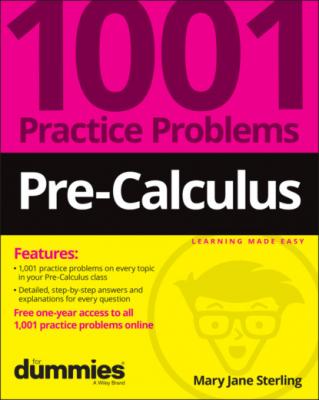ТОП просматриваемых книг сайта:
Pre-Calculus: 1001 Practice Problems For Dummies (+ Free Online Practice). Mary Jane Sterling
Читать онлайн.Название Pre-Calculus: 1001 Practice Problems For Dummies (+ Free Online Practice)
Год выпуска 0
isbn 9781119883647
Автор произведения Mary Jane Sterling
Жанр Математика
Издательство John Wiley & Sons Limited
Find:
437. Given:
Find:
438. Given:
Find:
439. Given:
Find:
440. Given:
Find:
Using the Arc Length Formula
441−445 Solve the problem using the arc length formula
441. The central angle in a circle with a radius of 20 cm is
442. The central angle in a circle of radius 6 cm is 85°. Find the exact length of the intercepted arc.
443. Find the radian measure of the central angle that intercepts an arc with a length of
444. The second hand of a clock is 18 inches long. In 25 seconds, it sweeps through an angle of 150°. How far does the tip of the second hand travel in 25 seconds?
445. How far does the tip of a 15 cm long minute hand on a clock move in 10 minutes?
Evaluating Inverse Functions
446−450 Find an exact value of y.
446.
447.
448.
449.
450.
Solving Trig Equations for x in Degrees
451−455 Find all solutions of the equation in the interval
451.
452.
453.
454.
455.
Calculating Trig Equations for x in Radians
456−460 Find all solutions of the equation in the interval
456.
457.
458.
459.
460.
Chapter 8
Graphing Trig Functions
The graphs of trigonometric functions are usually easily recognizable — after you become familiar with the basic graph for each function and the possibilities for transformations of the basic graphs.
Trig functions are periodic. That is, they repeat the same function values over and over, so their graphs repeat the same curve over and over. The trick is to recognize how often this curve repeats and where one of the basic graphs starts for a particular function.
An interesting feature of four of the trig functions is that they have asymptotes — those not-really-there lines used as guides to the shape of a curve. The sine and cosine functions don’t have asymptotes, because their domains are all real numbers. The other four functions have vertical asymptotes to mark where their domains have gaps.
The Problems You’ll Work On
In this chapter, you’ll work with the graphs of trigonometric functions in the following ways:
Marking any intercepts on the x-axis to help graph the curves
Locating and drawing in vertical asymptotes for the tangent, cotangent, secant, and cosecant functions
Computing the change in the period of a function based on some transformation
Adjusting the amplitude of the sine or cosine when the basic curve has a multiplier
Making

